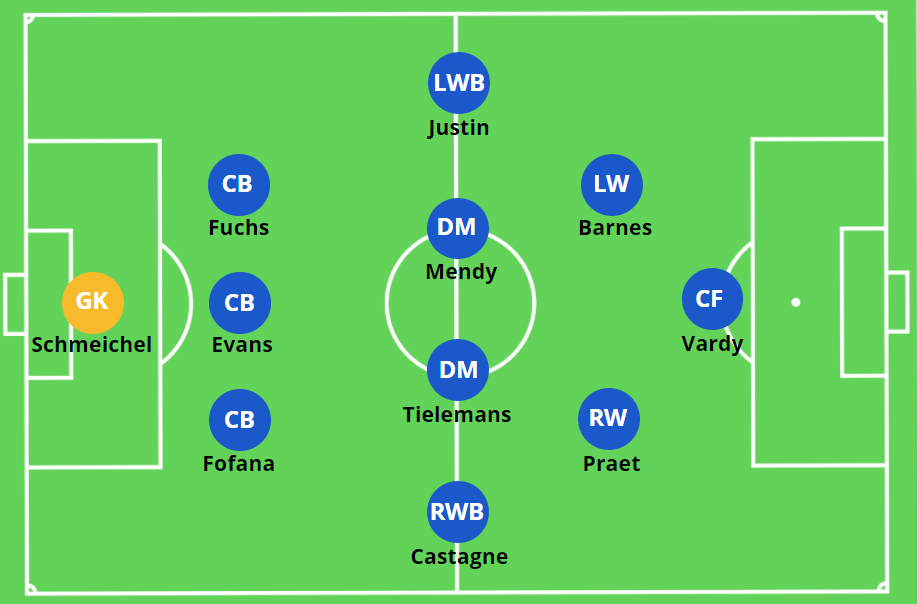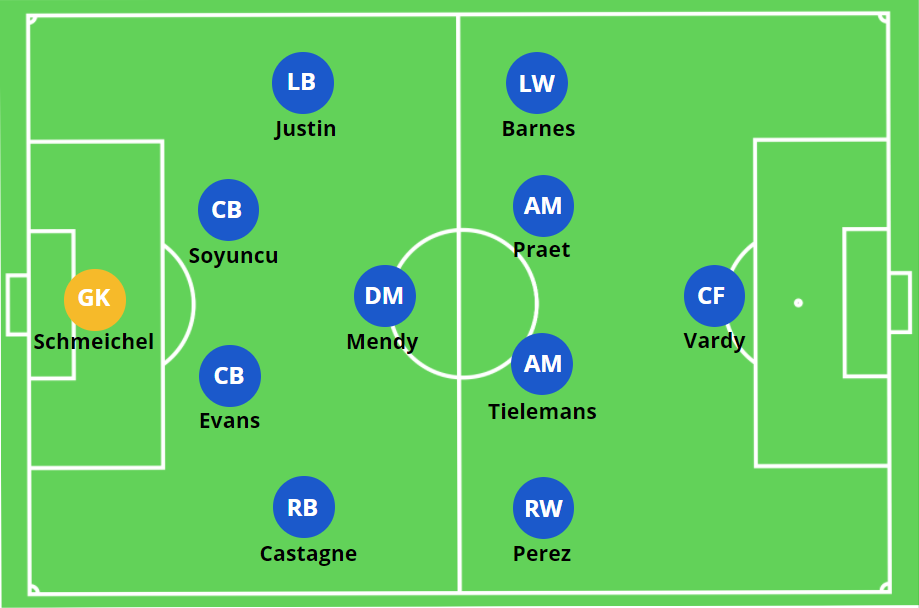After missing out on Champions League football on the final day of the 2019-20 season, many might have thought Leicester City’s early season form of last year might just have been a stroke of good fortune and nothing more. But their stellar play has continued at the start of 2020-21 and other than a few disappointing losses to West Ham and Aston Villa, the Foxes have been flying high to start this campaign. After eight matches, Brendan Rodgers’ side sit top of the table, with six wins so far. Significantly, they’ve experimented with different formations and a host of different, less luxurious players in the absence of talents like Ricardo Pereira, Wilfred Ndidi, James Maddison and of course Ben Chilwell, who left for Chelsea. Their impressive form after missing out on Champions League football last year definitely deserves further examination, so here is our early season tactical analysis of Brendan Rodgers’ Leicester City in 2020-21.
system of play: 3-4-2-1

Time will tell how long Leicester stick to this system of play, but Brendan Rodgers’ side look to have adapted quickly and well to a 3-4-2-1 formation, following a spectacular 5-2 win over Manchester City, in which they played a slightly more defensive variation of the system (more like 5-4-1 that day). The new formation might only be present at the moment due to Wilfred Ndidi’s absence, compounded by the injuries to Caglar Soyuncu and Jonny Evans. As a result, we will still explore Leicester’s potential preference to, in time, move back into a 4-1-4-1 formation. But for now, Rodgers looks like a tactical genius for getting the absolute best out of his players in the absence of so many top level stars. The 3-4-2-1 has allowed Leicester more defensive stability in midfield, where even in the 4-1-4-1, Youri Tielemans was playing relatively low alongside Mendy to help cover the gap. Mendy has proven to be a useful option for the Foxes this season, but the absence of Ndidi is still somewhat felt by the Foxes, who can’t help but miss their tough-tackling defensive midfielder. In the 3-4-2-1, it’s become more natural for Tielemans to adopt a defensive position alongside Mendy, decreasing the burden that the Frenchman feels to live up to the boots of what is practically an impossible job for him to do alone. Simultaneously, it’s allowed the Foxes to rotate their squad more often, given the flexibility a system that incorporates both outside-backs and wing-backs can have. With the Foxes also needing to perform in the Europa League this season, players like James Justin, Christian Fuchs and Dennis Praet have already been given more game-time, with Rodgers recognizing the versatility such players possess.
Against some of the common wisdom of keeping squads small and reducing player rotation, Rodgers has given 23 different players playing time so far in 8 games, 18 of which have started at least 2 league matches. This is partially out of necessity due to injuries to key players. But it’s also out of the manager’s desire to engage in formation rotation more so than player rotation. The former Liverpool and Swansea manager has deployed at least three distinctly different formations so far this season, and there is some argument that his 4-1-4-1 even looks more like 4-2-3-1 this season than in the past. The players have all responded massively well to the constant changes and Rodgers definitely deserves immense credit for ingraining his values into training, to allow for these changes of shape to occur so seamlessly.
We’ll explore the in’s and out’s of this system and how Leicester have been operating as the article moves along, but for now it is important to note which of the 23 players have been mainstays. As ever, Kasper Schmeichel has been an ever-present in goal and Jamie Vardy remains Leicester’s most important player, regardless of formation. Vardy’s 23 goals in 35 matches last season was good enough to win the Golden Boot, and he’s already on his way to a repeat, with 8 goals in 7 appearances so far. He’s been paired most often with the dynamic Harvey Barnes and the neat-and-tidy Dennis Praet, who’s been operating as an inverted right winger, drifting into central areas as Timothy Castagne or Marc Albrighton overlap him down the wing. Nampalys Mendy and Youri Tielemans have formed a solid partnership in midfield, with Tielemans having more freedom to make forward runs. In behind, the defense has been the least consistent, as have the wing-back’s who have been disrupted by an injury to Timothy Castagne. James Justin has surprisingly been the only one to play all 8 games so far, operating in three different positions across the back five. Wesly Fofana’s stellar start to life in Leicester may also convince Rodgers to stick with a back-three for a little while longer, even if Soyuncu and Evans become fit again together. For now, Christian Fuchs and Luke Thomas may see more action as Soyuncu and Castagne await a return to action.
alternate system of play: 4-1-4-1

In addition to the 3-4-2-1, Leicester have also had reasonable success deploying their standard 4-1-4-1 formation this season, even despite all the absences of key players. As already noted, Youri Tielemans has been playing deeper and deeper, looking to get on the ball, while also providing a second shield to help Mendy cover the massive boots left by Ndidi. This makes the formation at times look more like 4-2-3-1, with Dennis Praet as the central attacking midfielder in the 3. As we discussed in our Leicester Tactical Analysis of 2019-20, the 4-1-4-1 was almost predicated on Ndidi’s presence in midfield, which allowed talented ball-playing midfielders like Tielemans and Maddison to get on the ball higher up the field. Without Ndidi, it’s understandable that Rodgers has made the slight adjustment for Tielemans to take on a more defensive approach. Crucially, the attack-minded nature of the fullbacks has continued in the 4-1-4-1 formation, as Timothy Castagne and James Justin take turns getting up and down the line. Last season that demanding job was given to Ricardo Pereira and Ben Chilwell, two of Leicester’s key performers in their fight for Champions League football. However, Rodgers has provided evidence that it’s not just the talent of those players that make the system work, but the system itself that makes those players function so effectively, knowing they have a defensive screen behind them in the form of Wilfred Ndidi, or this season – the slightly less mobile Nampalys Mendy. It is also surprising that Timothy Castagne has been the one to provide more attacking output (or most recently Marc Albrighton), as right-sided Youri Tielemans is the more defensively minded midfielder as part of the four. Further, the right-winger, whether it be Ayoze Perez or Dennis Praet, tends to be more inverted for Leicester than the out-and-out Harvey Barnes. It will therefore be particularly interesting to see whether Castagne continues to have the same attacking output if he moves to the left upon Ricardo Pereira’s return.
Now let’s get more into the tactics and triangles of this Leicester City side.
VARDY & BARNES COMBINATION PLAY
Embed from Getty ImagesIn the days of Jamie Vardy and Riyad Mahrez, Leicester City had two genuine attacking stars, often winning matches on their own with individual brilliance. Jamie Vardy’s role in the team has evolved over the years and now he is linking up brilliantly well with Harvey Barnes, in a way where Mahrez never really did. Mahrez was more of an incisive passer and crosser of the ball, whereas Barnes is a willing runner who is capable of linking up with Vardy in ways that actually suits Vardy’s energetic style of play better. This is perhaps because other than the obvious incomparable goal-return, Barnes is very similar to Vardy’s prototype. He’s a dangerous speedster, a capable dribbler, and intelligent at one-and-two touch play in and around the eighteen yard box, particularly on the break. It’s natural then that Vardy often starts his runs closer to the left, particularly in counter-attacking situations, knowing that the speedy Barnes will soon join him. Barnes is both their top and most successful dribbler, in addition to the player that takes the most shots per game. A lot of the attacking situations they engage in end up being on the counter-attack, an increasingly important feature of their play, especially in the 3-4-2-1 formation. We spoke last year about how the 4-1-4-1 formation is typically used in teams who can afford only one defensive midfielder due their domination on the ball. At that time, Leicester had 55% of the ball after 7 matches in 2019-20. This season, it’s been closer to 50%, a noticeable drop-off that has contributed to a greater reliance on counter-attacking play as they so successfully did when they won the title in 2015-16. This has been a prominent feature of their play once again, allowing Barnes and Vardy to engage in quick attacking transitions down the left-wing. It’s no surprise that 24% of their shots come down the left-side (the 4th highest in the league) and that this percentage only dropped with Harvey Barnes’ exclusion to the team against Wolverhampton Wanderers.
It is also important to mention that Leicester don’t just take shots for the sake of it. They look for the right moments to get into the box. They’ve only taken 9.4 shots per game (14th best), but they’ve scored 18 goals (tied for 3rd best). Instead of shooting from far away, they prefer quick combinations and the dribbling power of players like Barnes, Vardy and Castagne. This has contributed to Leicester winning 8 penalties so far this season, where they’ve scored 7/8. Unsurprisingly, this is nearly double the amount of any other team in the league (Liverpool have scored 4 in second place). Showcasing their desire to get closer to the goal before shooting, 63% of their shots have come from within the eighteen-yard box (the second highest percentage, only behind Leeds). This provides further evidence to just how important Barnes and Vardy’s link-up play has been in the attacking third, looking for the right moments to get into the box, win a penalty or take a shot.
attack-minded fullbacks (expanded)
Embed from Getty ImagesWe spoke very briefly already about the attack-minded nature of Leicester City’s fullbacks and how that has continued this season with the arrival of Timothy Castagne. The Belgian defender has been a revelation at right-back/right-wing-back this season for Leicester and has formed his own special partnership with Jamie Vardy. Like Ricardo Pereira before him, Castagne is a powerful runner of the ball, capable of covering ground at both ends of the pitch. He’s also a dangerous crosser of the ball and makes intelligent late runs into the box to get on the end of crosses from the left-hand-side. But unlike the play of last season in which Chilwell and Pereira would both often be found high up the pitch, James Justin has been a little bit more stay-at-home than his predecessor. This has allowed for greater fluidity in attack down the right side where Castagne has been given more freedom to work his magic, much to the joy of Fantasy Premier League managers in the early days of the campaign. Unlike just about every Premier League team, Leicester are one of the few that actually attack down the right and left to an equal extent (38% each to 25% in the middle). But interestingly, Leicester’s attacks down the left rarely come from the fullbacks and usually more so from counter-attacking situations or the willing runs of Harvey Barnes and James Maddison (when he comes off the bench). The right-side has actually been where they’ve achieved more intricate play, with the likes of Tielemans and Praet combining with an overlapping fullback in Castagne or Albrighton. This allows Leicester two advantages. Firstly, they can create overloads in central areas as Praet or Ayoze Perez drift inside to cause further confusion to a position already occupied by Tielemans. Secondly, the opposition don’t know who to mark as the right-wing-back gallops down the right. Given how talented Tielemans and Praet are on the ball themselves, the wing-back might not even see the ball. But the opposition still have to track the run. If they don’t, the wing-back will almost certainly see the ball and look to create a chance from the widea area. Ultimately, it’s all about overloads and chaos, which is something Leicester have achieved to a great extent this season. It’s also important that they’ve achieved this balance, given that it would have been very easy for it to fall apart without Pereira and Chilwell.
defensive shape & compactness
Embed from Getty ImagesLeicester City don’t engage in a high-pressing system, instead operating in more of a mid-block. Their defensive shape often resembles a 5-4-1 when playing 3-4-2-1, with the wing-back’s tucking in deeper and the inverted wingers defending alongside the central midfielders. The Foxes remain extraordinarily tough to break down, just as they did in Claudio Ranieri’s charge toward the title. This is particularly due to their patience when defending. Individual players may press the player on the ball with a touch of intensity, but hardly ever much in the way of aggression or over-exertion. The Foxes have conceded the third least amount of fouls per game this season (10.3), while simultaneously making the second most amount of interceptions per game (12) and sixth most amount of tackles per game (16.5). This demonstrates their patience in defense, shifting and sliding with the play and waiting for the right moment to time their attempt to win the ball back. Further highlighting their defensive organization, they’ve been dribbled past the third least amount of times per game this season (6.9). This shows just how organized Brendan Rodgers’ side have been in defense, allowing no route forward for their opposition to break the lines with a pass or dribble.
conclusion
Embed from Getty ImagesAfter eight games in 2020-21, Leicester City sit top of the table. Their defensive organization, in conjunction with their attacking fluidity and combination play of the front-three and full-backs, has made Brendan Rodgers’ side one of the most exciting teams to watch so far this season. Whether or not Leicester can do the unthinkable again and win the Premier League remains to be seen, but for now the Foxes have been extraordinary, and may well be on their way to doing something special once again in 2020-21.
So there it is! A tactical analysis of Brendan Rodgers’ Leicester City. Be sure to check out more of our Tactical Analyses, and share your thoughts in the comments below or on Twitter @mastermindsite. Thanks for reading and see you soon!
You might also enjoy…
-> David Moyes – West Ham United – Tactical Analysis
-> Jose Mourinho – Tottenham Hotspur – Tactical Analysis
-> Dean Smith – Aston Villa – Tactical Analysis
-> Carlo Ancelotti – Everton – Tactical Analysis


17 thoughts on “Brendan Rodgers – Leicester City – Tactical Analysis (2020-21 Edition)”